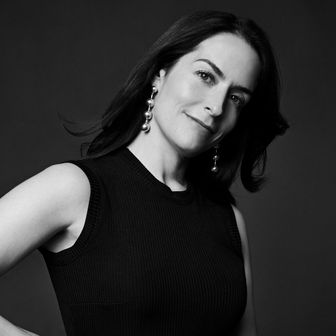
Kate Lewis is the chief content officer of Hearst Magazines, which publishes countless magazines across the globe, including Harper’s Bazaar, Elle, and Cosmopolitan. Lewis oversees Hearst’s editors-in-chiefs and directs content strategy for the publisher’s print and digital brands, which reach an audience of 145 million readers each month — including 70 percent of U.S. women. She lives in New York with her husband and two kids. Here’s how she gets it done.
On a typical morning:
If I’m being honest, the first thing I do is look at Instagram while lying in bed, but then I read things, too. I read the New York Times. A woman who works at Hearst turned me on to Media Star, which is a newsletter. It’s just a list of links that tells you all the media gossip from the day before. I’m addicted to that. It’s the second thing I do, sometimes even before Instagram. It’s usually a subway-phone-situation.
On social media:
The only one I really use is Instagram. I read Twitter for the news, but usually at night, because in the morning people haven’t said anything interesting yet. What I like about Instagram is that not only is it now a news source for me, but I also get to be creative on it. I love Instagram Stories. I travel a lot for work and for fun, and I like to craft travel journeys.
On to-do lists:
Once a week I write down everything on my to-do list. It’s a full page of items in eight-point font, and it’s a tremendously overwhelming thing. Then I throw it out. I figure whatever I can remember from what I’ve written down is what I really have to do, and everything else is kind of bullshit. It’s so good. For so long I had notebooks and downloaded to-do list apps, and as soon as I wrote everything in there, I was mad. So I was like, okay, I’m going to try a new approach, and this has been very effective for me. If you fall off the list, sorry!
On managing her inbox:
If you email me and I don’t respond, you have to email me again. I need a nudge. I travel a lot, and on airplanes I sort my inbox by sender and go through by human. I’ll search for all the emails from “Stella,” and deal with it for Stella. Then when I get off the plane, that person gets like 5,000 emails from me, but that’s how I do it.
I’m self conscious about emailing people at night or on the weekends because I think they will feel like they should respond, and I don’t really want them to. So, I actually turn off my email during off-hours and then wait to send them at a normal time. If I’m doing email late at night, I won’t send it until the morning.
On managing managers:
I try to manage with compassion. It’s something I’ve thought a lot about because I think often people who seem optimistic and smiley — which is just my general nature — are perceived as not gritty or tough enough to manage. I really want to fly in the face of that.
The other thing that feels critical to management in such a big organization is to be decisive. I really value that not just in myself but in other people. We don’t have time to waffle. Things are happening fast. Not all decisions are good decisions, but we always go in a direction that feels like the better path. When I am waffling, I love that there are so many people around me who I can talk things through with to come to a decision.
On working with millennials:
I really don’t believe the whole “millennials are hard to manage” thing. I think that’s hogwash. The majority of people who work for me are millennials, and they are the most ambitious people I’ve ever met, which I really value in a human. And they’ve been extraordinarily loyal to Hearst. I hear a lot that millennials are loyal only to themselves, but I haven’t seen that so much.
On creating editorial content:
We live in an age of SEO, and it’s really easy now to just write for the search term. We’re quite good at that at Hearst, but the risk is, if you do that, you can walk away from inspiration. So, how do you marry “this is cool” versus “this is necessary,” and make them both daily and habitual? How do we inspire teams both in terms of metrics and in terms of delight, which is harder to measure?
If management is only saying congratulations for the numbers, then you’re only going to get the numbers. But if management is saying congratulations for this delightful story I came across today that made me feel something, then people will listen. The onus is on us to continue to give that kind of feedback.
On delivering bad news:
Our organization is really good at transparency. There isn’t a lot of subterfuge or politics. You’ve got to face things head on, especially when everything is changing so fast. You have to lay things out and look at them, good and bad.
On receiving bad news:
If good people leave, you’re mad. Sometimes when people quit, my first reaction is to shut them out because I’m pissed. But I’m working on that because you can’t let those kinds of things destroy you. As a result, we’ve actually managed to hire back people in time, [which is possible] if you’re not crappy to them on the way out.
On managing stress:
I wouldn’t say I’m particularly good at managing stress, but I’m good at living with it. I think stress is part of what makes me optimistic, because stress and excitement are related. Sometimes stress is just a major downer, but sometimes stress is anticipation — the open door of something new.
On advice to her younger self:
I’m going to steal advice from Oprah. One of her pieces of advice, which is very counterintuitive, is to surrender. If there’s something you truly want, let it go. I really believe in ambition, but I love the idea of letting it take its course, or not. When I think about that advice, I can see how it’s played out in my own life. Sometimes, I feel that my success is accidental, because I didn’t overly strategize it. The journey will happen.
This interview has been edited and condensed.





